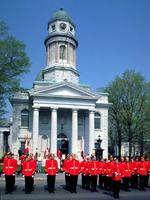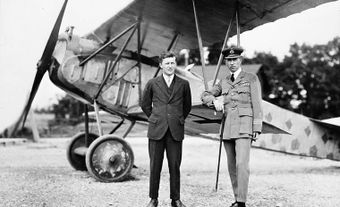
Military and Staff Colleges
Canada's military colleges (formerly Canadian services colleges) educate and train officers and officer cadets for ARMED FORCES careers. In 1994, federal cuts to the defence budget on the order of $1.3 billion forced the closure of two of Canada's three military colleges, leaving only ROYAL MILITARY COLLEGE (RMC). Royal Roads Military College (RRMC) was closed in 1995, as was Le Collège militaire royale (CMR). The latter was re-opened in 2007. In 2000 the Canadian Defence Academy (CDA) was established and assumed responsibility for education and professional development from the Canadian Forces Recruiting Education and Training System. It also oversees RMC and the Canadian Forces College.RMC opened 1 June 1876 at Kingston, Ontario. It stands on the site of significant historic events. Kingston had been established as a refugee settlement for United Empire Loyalists in 1783-84. Though Kingston was not ideal for a naval station, it was Upper Canada's major population centre and therefore was officially a logical choice.
The War of 1812 transformed the little town of Kingston. In 1813 the Royal Navy absorbed the small army naval establishment. Kingston was the key to Upper Canada and the presence of the Royal Navy on Lake Ontario ensured its successful defence. Dockyard facilities were improved and several stone buildings erected, including a stone warehouse known as the Stone Frigate, which still exists.
Before the establishment of RMC, Canadian officer cadets had to study in England. Prime Minister Alexander Mackenzie supported the idea of setting up a Canadian military school when it was proposed by LCol Walker Powell, acting Adjutant-General of Militia in 1874. Powell suggested an institution that would provide a military and scientific education.
The government passed an Act to establish a military college and Kingston, with its military history, was selected as the college site. Some of the buildings of the Naval Dockyard were used for accommodation. The school was modelled after the United States Military Academy at West Point. It opened on June 1, 1876 with a class of 18 cadets. RMC received degree-granting status in 1959. The first graduate to receive his RMC degree was Desmond Morton, one of Canada's most widely read historians and contributor to The Canadian Encyclopedia.
Royal Naval College of Canada, authorized by the 1910 NAVAL SERVICE ACT, opened at Halifax, Nova Scotia in 1911; as a result of the 1917 HALIFAX EXPLOSION it moved to RMC, then in 1918 to the former British dockyard at Esquimalt, BC. It closed June 1922, and for 20 years naval cadets attended Royal Naval College, Dartmouth, England. As a result of wartime expansion the new Royal Canadian Naval College, Royal Roads, opened near Esquimalt in 1942.
RRMC was established on land around the Esquimault Lagoon. In 1790 Sub-Lt Don Manuel Quimper anchored his ship in the roadstead and claimed the land for Carlos IV of Spain. (A roadstead is an area where ships can anchor safely near shore, though not as safely as in a harbour. "Roads" is a short form, hence Royal Roads.) There was a small settlement on the area; much of the property was sold to the British Navy in Esquimault Harbour. It was eventually purchased by Roland Stuart, who named the estate Hatley Park.
In 1907 James Dunsmuir, a Vancouver Island industrialist and president of E&N Railway, and Premier and later Lt Gov of BC, acquired the first 600 acres of the property. He added to it later. He built a $4 million house, called Hatley Castle. He commissioned beautiful and expansive gardens on the property, which remain. After Dunsmuir's death in 1920, his widow Laura continued to live at the castle. The Government of the Dominion of Canada bought Hatley Park for $75,000 in 1940, roughly the value of the fence surrounding the property. On December 13, HMCS Royal Roads was commissioned to train naval officers during WWII.
In 1942, the institution became the new Royal Canadian Naval College. In 1947 the college was renamed the RCN-RCAF Joint Services College, as air force and navy training were combined. In 1948 the name was changed again to Canadian Services College, Royal Roads, when it became a tri-service military college. Royal Roads, with a two-year program, was a feeder school for RMC's four-year program. The name was officially changed to Royal Roads Military College in 1968. It received degree-granting status in 1975. The first graduation of a fourth-year class was in 1977.
In 1952 CMR was established at St-Jean, Québec, primarily for French-speaking officer cadets. CMR was set up as a feeder school for RMC, with the purpose of increasing the number of francophones in the officer corps. It provided the opportunity to achieve higher rank to two under-represented groups - French Canadians and Atlantic Canadians. CMR received degree-granting status in 1971 (with UNIVERSITÉ DE SHERBROOKE). With the three military colleges came the Regular Officer Training Plan (ROTP). In response to the Cold War and NATO commitments, the Canadian government had authorized a large standing peacetime military force. Women were admitted to RMC post-graduate degree programs in 1978, and female cadets were enrolled in the Regular Officer Training Plan in September 1980.
After commissioning, an officer's professional development and education may include courses at other military educational institutions. Canadian Forces College (CFC) is a professional development institution. Officers are selected to attend CFC by National Defence Headquarters based on professional merit. Most promotions to LCol and Col (and Navy equivalents) depend on successful completion of CFC courses.
CFC was founded in 1943 at Armour Heights as the RCAF War Staff College. Its reorganization over the intervening years reflects the evolution of the professional development of Canadian military officers. In 1945 it became the RCAF Staff College and in 1962 a component of the Air Force College, which also included a Staff School and an Extension School. The latter operated in conjunction with the U of Toronto between 1963 and 1974. In 1966 a new course designed to meet the requirements of the unified force structure was introduced as part of the CFC's curriculum.
In 1974 the Staff College Course became the Command and Staff Course that exists now. The CFC's role expanded in 1998 to include advanced courses in military studies and national security. The Canadian Land Forces Command and Staff College, Kingston (opened as a Canadian Army Staff College during WWII), offers a tactics-oriented course for operational command and staff duties.

 Share on Facebook
Share on Facebook Share on X
Share on X Share by Email
Share by Email Share on Google Classroom
Share on Google Classroom

